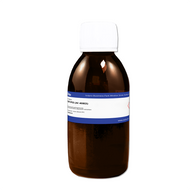Aqueous PEDOT:PSS Formulation
Used for applications in OPV and perovskite solar cells
Specifications | MSDS | Resources and Support
HTL Solar (CAS number 155090-83-8) is an aqueous PEDOT:PSS formulation designed for use in thin film electronics as an interfacial material. The advantage of HTL Solar is its improved wetting properties, particularly in inverted OPV cells, compared to the other PEDOT:PSS formulations.
Increased Wettability
Ideal for inverted OPVs and other thin films with wetting difficulties
Versatile Use
Applications in OPV, OLED and perovskite solar cells
High Quality
Quality Formulation
Tailored Conductivity
Relatively high conductivity, 0.1 – 1.0 S/cm
![]()
PEDOT:PSS (HTL Solar) from Ossila was featured in the high-impact paper (IF 16.6), Ultra-high resolution imaging of thin films and single strands of polythiophene using atomic force microscopy, V. Korolkov et al, Nat. Commun., 10, 1537 (2019); DOI: 10.1038/s41467-019-09571-6; and paper (IF 17.6), Continuous, crystalline Sb2S3 ultrathin light absorber coatings in solar cells based on photonic concentric p-i-n heterojunctions, P. Büttner et al., Nano Energy, 103 (B), 107820 (2022); DOI: 10.1016/j.nanoen.2022.107820.
Technical Data
| Product Name | Clevios™ HTL Solar |
|---|---|
| Solvent | Water |
| Composition | PEDOT/PSS (1:2.5 w/w) |
| CAS Number | 155090-83-8 |
| Solid Content | 1.0 – 1.3 wt.% |
| Work Function | 4.8 – 5.0 eV |
| Resistivity | 1 – 10 Ω.cm |
| Sheet Resistance | 10E4 – 10E6 Ω/sq, +10E6 Ω/sq |
| Conductivity | Relatively high conductivity, 0.1 – 1.0 S/cm |
| Particle Size Distribution | N/A |
| Viscosity | 8 – 30 mPa.s |
| pH Value | ~2 |
| Packaging | 100 ml of solution sealed in a light resistant bottle with temperature indicator |
| Storage | 3 – 5 °C |
Spin Speed Data
 HTL Solar Spin Speed / Film Thickness
HTL Solar Spin Speed / Film Thickness
MSDS Document
HTL Solar PEDOT:PSS MSDS Sheet
Related Products
Resources
 How to Spin Coat PEDOT:PSS
How to Spin Coat PEDOT:PSS
For the deposition of thin films of PEDOT:PSS on a freshly prepared surface, we recommend using a vacuum-free spin coater and following this five-step process:
Read more...PEDOT synthesis involves the oxidative chemical or electrochemical polymerization of EDOT monomer. The choice of counterions and polymerization method significantly affects the conductivity, work function, and stability of the resulting PEDOT polymer.
Read more...



